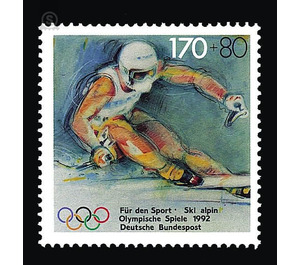sport aid - Germany / Federal Republic of Germany 1992 - 170 Pfennig
Theme: Post & Philately
| Country | Germany / Federal Republic of Germany |
| Issue Date | 1992 |
| Face Value | 170.00 |
| Color | multi-colored blue |
| Perforation | K 13 3/4 |
| Printing Type | Multicolor offset printing |
| Stamp Type | Postage stamp |
| Item Type | Stamp |
| Chronological Issue Number | 1468 |
| Chronological Chapter | GER-BRD |
| SID | 960309 |
| In 37 Wishlists | |
At the turn of the century, skiing was transported from its cradle Norway to the Alpine countries. Here it was the German Wilhelm Paulcke, who in 1897 with his crossing of the Bernese Oberland on skis left the last doubts about the suitability of skiing in the Alps. In 1905, for example, the German Ski Association was founded in Munich. With the beginning of cable car construction in 1924, alpine skiing quickly developed from general skiing. But it was not until many years after Nordic skiing that alpine skiing became a competitive sport and in 1930 it was recognized by the World Ski Federation - the FIS. For the first time in 1931 at World Championships and 1938 at the Olympic Games was the Alpine racing with downhill skiing and slalom in the competition program. Since then, it has been part of the standard program of these major winter sports events and enjoys great popularity. In Germany, alpine sports were first included in the championship program in 1934. Christl Cranz and Helmut Lantschner were the first German champions. Since then, alpine sports have a long tradition in Germany. Alone Christl Cranz was in the years 1934 to 1939 fourteen times world champion and Olympic champion. These successes could be continued by the German racers such as Ludwig Leitner, Markus Wasmeier, Frank Wörndl and Hansjörg Tauscher as well as the ladies of Heidi Biebl, Rosi Mittermaier, Maria Epple and Marina Kiehl. Today, this popular winter sport has developed so far that in addition to the original disciplines downhill and slalom with the giant slalom, the super-G and the alpine combination further disciplines are an integral part of the competition programs. International alpine skiing is now operated by 64 member associations of the FIS; Millions of people in the northern and southern hemispheres recover year by year with this beautiful sport. (Text: Stiftung Deutsche Sporthilfe, Frankfurt am Main)


